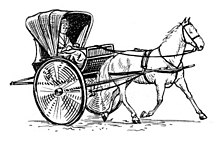Chaise

A one-horse chaise

A three-wheeled "Handchaise", Germany, around 1900, designed to be pushed by a person
A chaise, sometimes called chay or shay, is a light two- or four-wheeled traveling or pleasure carriage for one or two people with a folding hood or calash top.[1] The name, in use in England before 1700, came from the French chair through a transference from a sedan-chair to a wheeled vehicle.[2]
Design
The two-wheeled version, usually of a chair-backed type, for one or two persons, also called a gig or one-horse shay, had a body hung on leather straps or thorough-braces and was usually drawn by one horse; a light chaise having two seats was a double chair.
A chaise-cart was a light carriage fitted with suspension, used for transporting lightweight goods.[1]
A bath chair was a hooded and sometimes glassed wheeled chair used especially by invalids; it could be drawn by a horse or pushed by an attendant.
Other types of chaise included:
post chaise : designed for fast long-distance travel
curricle: two-wheeled, usually drawn by two horses
calesín: small, one-horse, hooded, a seat behind for the driver, used in the Philippines
shandrydan or shandradan: with a hood
During the winter of 1791/92, in the opening phases of the French Revolution, Henrietta Ponsonby, Countess of Bessborough, noted the lack of ostentation in the streets of Paris, where a few drove themselves about in "little open chaises like the cabriolet but with one horse."[3]
See also
Post chaise
References
^ ab Cowie, L.W. (1996). The Wordsworth Dictionary of British Social History. Wordsworth Reference. p. 55. ISBN 1-85326-378-8..mw-parser-output cite.citation{font-style:inherit}.mw-parser-output .citation q{quotes:"""""""'""'"}.mw-parser-output .citation .cs1-lock-free a{background:url("//upload.wikimedia.org/wikipedia/commons/thumb/6/65/Lock-green.svg/9px-Lock-green.svg.png")no-repeat;background-position:right .1em center}.mw-parser-output .citation .cs1-lock-limited a,.mw-parser-output .citation .cs1-lock-registration a{background:url("//upload.wikimedia.org/wikipedia/commons/thumb/d/d6/Lock-gray-alt-2.svg/9px-Lock-gray-alt-2.svg.png")no-repeat;background-position:right .1em center}.mw-parser-output .citation .cs1-lock-subscription a{background:url("//upload.wikimedia.org/wikipedia/commons/thumb/a/aa/Lock-red-alt-2.svg/9px-Lock-red-alt-2.svg.png")no-repeat;background-position:right .1em center}.mw-parser-output .cs1-subscription,.mw-parser-output .cs1-registration{color:#555}.mw-parser-output .cs1-subscription span,.mw-parser-output .cs1-registration span{border-bottom:1px dotted;cursor:help}.mw-parser-output .cs1-ws-icon a{background:url("//upload.wikimedia.org/wikipedia/commons/thumb/4/4c/Wikisource-logo.svg/12px-Wikisource-logo.svg.png")no-repeat;background-position:right .1em center}.mw-parser-output code.cs1-code{color:inherit;background:inherit;border:inherit;padding:inherit}.mw-parser-output .cs1-hidden-error{display:none;font-size:100%}.mw-parser-output .cs1-visible-error{font-size:100%}.mw-parser-output .cs1-maint{display:none;color:#33aa33;margin-left:0.3em}.mw-parser-output .cs1-subscription,.mw-parser-output .cs1-registration,.mw-parser-output .cs1-format{font-size:95%}.mw-parser-output .cs1-kern-left,.mw-parser-output .cs1-kern-wl-left{padding-left:0.2em}.mw-parser-output .cs1-kern-right,.mw-parser-output .cs1-kern-wl-right{padding-right:0.2em}
^ Chisholm, Hugh, ed. (1911). . Encyclopædia Britannica. 5 (11th ed.). Cambridge University Press. p. 802.
Chisholm, Hugh, ed. (1911). . Encyclopædia Britannica. 5 (11th ed.). Cambridge University Press. p. 802.
^ Janet Gleeson, Privilege and Scandal: The Remarkable Life of Harriet Spencer, Sister of Georgiana 2006:130.